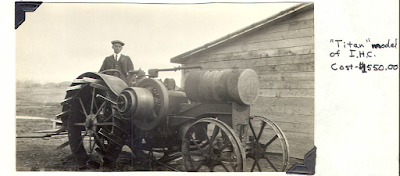52 Ancestors in 52 Weeks
Week 43
Prompt – Transportation
Our immigrant ancestors sailed across
the Atlantic Ocean to get to The Americas. Using the passenger lists available on Ancestry I have been able to establish the ships that they sailed on to get here. The
internet provides so much information such as the postcard type
photos of their ships. It is one more thing that allows me to
visualize my ancestors and their journey to Canada and United States.
My Paternal Great Grandparents, David
and Katharina (Nee Mueller) and their 7 children left Hamburg,
Germany aboard the S.S. Canadian. They left July 2, 1875 from
Hamburg. They were among many of their fellow Mennonites from South Russia.
They went via Liverpool to their destination of Hull, Quebec, Canada landing July 19, 1875.
They went via Liverpool to their destination of Hull, Quebec, Canada landing July 19, 1875.
 |
| S.S. Canadian |
This is what a transcription of their Passenger Lists looks like on Ancestry.
I don't know why it says the ship name is Hansa when every other document I have lists their ship as the S.S. Canadian. I have noted that ships are traded often between the shipping companies and when this happens their name is changed.
My Maternal Great Grandparents, Andreas and Maria (Nee Kraft) Krikau and their 5 children left Libau, maybe Russia or Latvia, and landed at Ellis Island in New York City, United States on October 17, 1911.
 |
| Maria and Andreas Krikau on Unknown Date. |
 |
| S.S. Birma |
Ellis Island has done a great job of putting their immigration information on line and selling it! I could order a certificate from Ellis Island that would look like the one above for my grandmother Maria Krikau or any of the other Krikau family on that voyage. It is my plan to visit New York and Ellis Island one day.
Bill's Paternal Great Grandparents,
Jacob and Eva (Nee Ereth) Hoffart along with 7 of their children came to Canada
May 20, 1913 via Antwerp, Belgium and landing Quebec, Canada.
They traveled on the S.S. Montreal.
 |
| Gravestone of Jacob and Eva Hoffart. |
 |
| S. S. Montreal in 1910. |
Their son, Bill's Paternal Grandfather, 24 year old, Rochus Hoffart came alone the following year. He left January 31, 1914 aboard the S.S. Cassandra. He traveled from Glasgow, Scotland to St John, New Brunswick on February 11, 1914. He traveled by train to Estevan, Saskatchewan to meet up with his family.
 |
| S.S. Cassandra |
Less than a month after, Rochus' bride to be, Marion Gross arrived in Canada aboard the ship Dwinsk. The ship left the port of Libau and arrived on April 7, 1914 in Halifax. She came alone and according to the passenger list she came as a "domestic". Rochus and Marion got married July 22, 1914. I do not know if this was a pre arranged marriage.
 | |
| Dwinsk. |
I have included the following interesting story of the ship Dwinsk which happened during WWI just a mere 4 years after Marion traveled across the Atlantic in it. I know it extends beyond the edge of my blog but I wanted you to read it without having to re type it for you.
Bill's Maternal Great Grandparents, Johann and Emelia (Nee Hein) Jahnke and their son Leonhardt departed Antwerp, Belgium and arrived in Philadelphia, Pennsylvania on November 9, 1891. They traveled aboard The Belgenland.
Johann and Emelia traveled with his brother, Leonhardt and his wife, Amelia (the twin sister of Emelia). Remember the brothers marrying twin sisters!
Johann and his family along with Leonhardt and his family went on to Winthrop, Minnesota where Bill's Paternal Grandfather, Arthur Jahnke was born to Johann and Emelia Jahnke.
Our ancestors spent weeks aboard ships to get from their home land to their new land with hopes and promises for a better life. In all cases they made the right decision to leave when they did. Two world wars, a Russian revolution, Communist brutality, displacement to Siberia and famine was the demise of their parents, grand parents, cousins, aunts, uncles and friends.
Wendy
 |
| April 20, 1890 Johann and Emelia Wedding Picture from Bromberg, Prussia. |
Our ancestors spent weeks aboard ships to get from their home land to their new land with hopes and promises for a better life. In all cases they made the right decision to leave when they did. Two world wars, a Russian revolution, Communist brutality, displacement to Siberia and famine was the demise of their parents, grand parents, cousins, aunts, uncles and friends.
Wendy








































